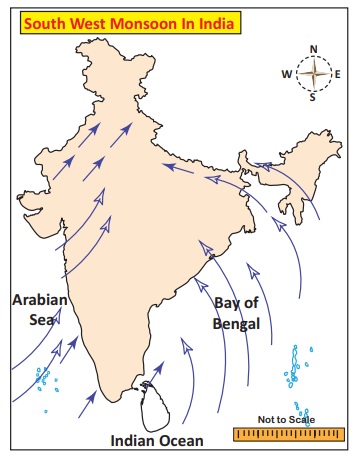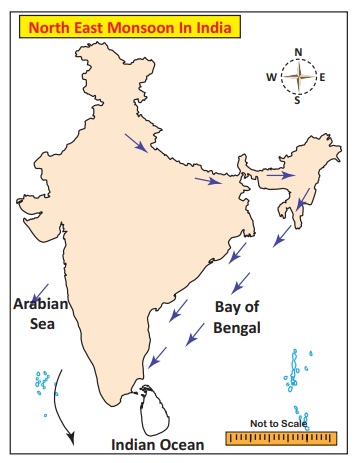Chapter: 10th Social Science : Geography : Chapter 2 : Climate and Natural Vegetation of India
Monsoon and Four distinct seasons in India
Monsoon
The word
‘monsoon’ has been derived from the
Arabic word ‘Mausim’ which means
‘season’. Originally, the word ‘monsoon’ was used by Arab navigators several
centuries ago, to describe a system of seasonal reversal of winds along the
shores of the Indian Ocean, especially over the Arabian Sea. It blows from the
south-west to north-east during summer and from the north-east to south-west during
winter.
Meteorologists have developed a number of concepts
about the origin of monsoons. According to the Dynamic concept, Monsoon wind
originates due to the seasonal migration of planetary winds and pressure belts
following the position of the sun. During summer solstice, the sun’s rays fall
vertically over the Tropic of cancer. Therefore, all the pressure and wind
belts of the globe shift northwards. At this time, Inter -Tropical Convergence Zone (ITCZ) also moves northward, and a major part of Indian landmass comes
under the influence of southeast trade winds. While crossing equator this wind
gets deflected and takes the direction of southwest and becomes south-west
monsoon. During the winter season, the pressure and wind belts shift southward,
thereby establishing the north-east monsoon (trade winds) over this region.
Such systematic change in the direction of planetary winds is known as monsoon.
Seasons
The
meteorologists recognize the four distinct seasons in India. They are;
1. Winter
season (January - February).
2. Summer
season (March - May).
3. Southwest
monsoon or Rainy season (June - September).
4. Northeast
monsoon season (October - December).
1. Winter season
During
this period, the vertical rays of the sun falls over tropic of capricorn which
is far away from India. Hence, India receives the slanting sun’s rays which
results in low temperature. The cold weather season is characterized by clear
skies, fine weather, light northerly winds, low humidity and large day time
variations of temperature. During this season a high pressure develops over
north India and a north-westerly wind blows down the Indus and Ganges valleys.
In south India, the general direction of wind is from east to west.
The rain
during this season generally occurs over the Western Himalayas, Tamil nadu and
Kerala. Western disturbances and associated trough in westerlies are main rain
bearing system in northern part of the country. The jet stream plays a dominant
role in bringing these disturbances to India. Western disturbances cause
rainfall in Punjab, Haryana and Himachal Pradesh, and snowfall in the hills of
Jammu and Kashmir. This rainfall is very useful for the cultivation of winter
wheat.
2. Summer season
During
this season, the vertical rays of the sun falls over the peninsular India.
Hence, there is a steady increase in temperature from south to north. It is
practically hot and dry in the entire country in the initial part of this
season. Weather over the land areas of the country is influenced by
thunderstorms associated with rain and sometimes with hail mostly in the middle
and later part.
During this season, temperature starts increasing
all over the country and by April, the interior parts of south India record
mean daily temperatures of 30°C–35°C. Central Indian land mass becomes hot with
day-time maximum temperature reaching about 40°C at many locations.
Because of the atmospheric pressure conditions, the
winds blow from southwest to northeast direction in Arabian Sea and Bay of
Bengal. They bring pre monsoon showers to the west coast during the month of
May. There are few thunder showers called “Mango
Showers” which helps in quick ripening of mangoes along the coast of Kerala
and Karnataka.
“Norwesters ” or “Kalbaisakhis” are the local storms with thunder that blow from
north western part and rain lasting for short durations. It occurs over the
eastern and north eastern parts over Bihar, West Bengal and Assam during April
and May. They approach the stations from the northwesterly direction.
3. Southwest monsoon or Rainy Season
The southwest monsoon is the most significant
feature of the Indian climate. The onset of the southwest monsoon takes place
normally over the southern tip of the country by the first week of June,
advances along the Konkan coast in early June and covers the whole country by
15th July. The monsoon is influenced by global phenomenon like ElNino.

Prior to the onset of the southwest monsoon, the
temperature in north India reaches upto 46°C. The sudden approach of monsoon
wind over south India with lightning and thunder is termed as the ‘break’ or ‘burst of monsoon’. The
monsoon wind strikes against the
southern tip of Indian land mass and gets divided into two branches. One branch
starts from Arabian sea and the other from Bay of Bengal.
The
Arabian sea branch of southwest monsoon gives heavy rainfall to the west coast
of India as it is located in the windward side of the Western Ghats. The other
part which advances towards north is obstructed by Himalayan Mountains and results
in heavy rainfall in north. As Aravalli Mountain is located parallel to the
wind direction, Rajasthan and western part do not get much rainfall from this
branch.
The Bay of Bengal branch moves towards northeast India and Myanmar. This wind is trapped by a chain of mountains namely Garo, Khasi and Jaintia are mainly responsible for the heaviest rainfall caused at Mawsynram located in Meghalaya. Later on, this wind travel towards west which results in decrease in rainfall from east to west. Over all about 75% of Indian rainfall is received from this monsoon.
4. Northeast monsoon season
The southwest monsoon begins to retreat from north
India by the end of September due to the southward shifting pressure belts. The
southwest monsoon wind returns from Indian landmass and blows towards Bay of
Bengal. The coriolis force deflects this wind and makes it to blow from
northeast. Hence, it is known as Northeast monsoon or Post- monsoon season. The
season is associated with the establishment of the north-easterly wind system
over the Indian subcontinent. Andhra Pradesh, Tamil nadu, Kerala and south
interior Karnataka receive good amount of rainfall accounting for 35% of their
annual total. Many parts of Tamil nadu and some parts of Andhra Pradesh and
Karnataka receive rainfall during this season due to the storms forming in the
Bay of Bengal. Large scale losses to life and property occur due to heavy
rainfall, strong winds and storm surge in the coastal regions. The day time
temperatures start falling sharply all over the country.

Related Topics